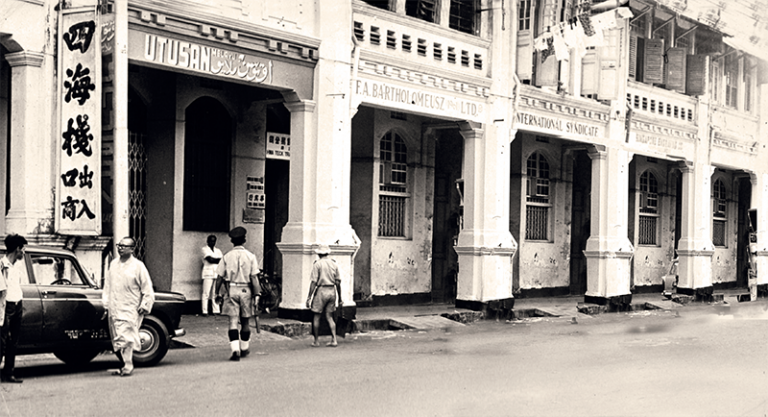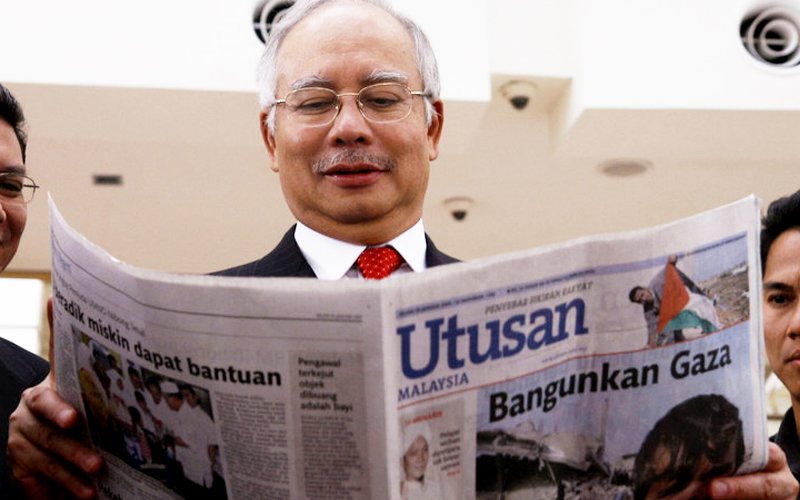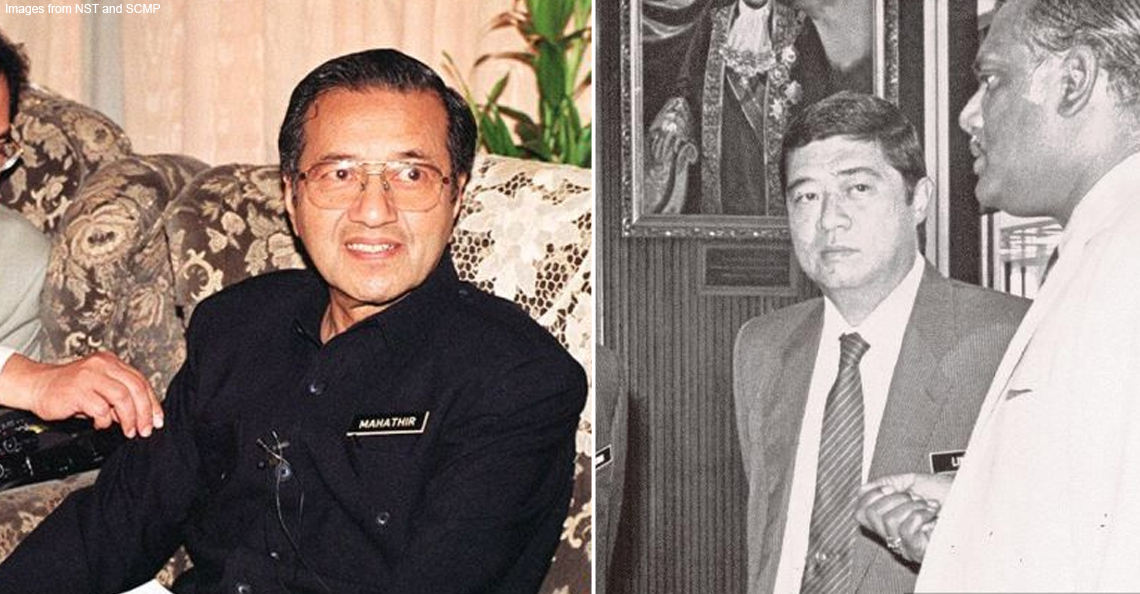A brief colourful history of Utusan. Yes, Lee Kuan Yew used to be Utusan’s lawyer.

- 619Shares
- Facebook541
- Twitter13
- LinkedIn6
- Email13
- WhatsApp46
[Artikel ini asalnya ditulis member member kami kat Soscili. Kalau nak baca artikel asal dalam BM, klik sini!]
[This article was originally published on Aug 22, 2019, but has since been updated to include recent events.]
If you enjoyed this story and want more like this, please subscribe to our HARI INI DALAM SEJARAH Facebook group ?
[UPDATED 9th Oct 2019: Utusan Melayu Sdn Bhd, publisher of Utusan Malaysia, had officially announced that they will cease operations today (9th Oct). According to a circular obtained by Malay Mail, their daily distribution kept dwindling, and coupled with a failure to reach advertising targets, their cash flow is in a critical state. So they’ve decided to cease operations. END OF UPDATE]
Even if you’re not a regular reader of news, you’ve probably heard that Utusan Malaysia and Kosmo!, newspapers published by Utusan Melayu (M) Bhd, will be stopping their print publications.

As for why, well, recently they seem to be having serious financial problems, with severance packages being offered to its workers, and a picket being held just this Tuesday by the remaining workers who have not been paid for two months.
While it was earlier said that Wednesday will be the last day of publication for both papers, after which they will only be doing digital content…
“On the front page, there will be a notice to inform readers that we will cease publication on Wednesday. This means that tomorrow (Tue, 19 Aug) we will work for the Wednesday publication. After that, we don’t have to work.” – Lokman Othman, editor of Kosmo!, as reported by NST.
An announcement on Tuesday revealed that they’ll continue publishing in print, but with a price hike of RM0.50 per copy for both Utusan Malaysia and Kosmo! starting Friday. Whew. That was a pretty close shave, but with the increasing popularity of the Internet, Utusan isn’t the only physical newspaper to suffer in recent years.
Some would be quick to point out that the change in government had something to do with the company’s (whose nickname is ‘lidah UMNO‘, or UMNO’s mouthpiece) downfall, but it hasn’t always been that way. Over its 80 or so years of publication, Utusan has had a colorful history behind it, and at one point it was even led by socialists, radicals, and nationalists.
Today, we’ll be looking at some interesting bits of that history, starting with the fact that…
Both the first President and Prime Minister of Singapore used to work for Utusan

Well, maybe not ‘work for‘ exactly, but more like ‘co-founded‘ and ‘provided legal services for‘ if you want to be picky about it. In the early 1900s, when newspapers were the bees knees as the main medium of news in Malaya, there was a gap in the market. There was no newspaper that catered to Malay issues specifically, and the closest thing then was probably Warta Malaya, an Arab-Malay-owned newspaper.
To fill that niche, in the 1930s a small group of Malays got together to create a newspaper that is 100% owned by the Malays, and in June 1938, Utusan Melayu Press Limited came into existence. A year later, on the 29th of May 1939, the first issue of Utusan Melayu hit the newsstands. One of the paper’s co-founders was a man named Yusof Ishak, who you might recognize as the first President of Singapore. Yusof became Utusan’s first Editor and Managing Director.

The other co-founder was Abdul Rahim Kajai, who today is widely considered as the father of Malay journalism. Besides the two, Utusan was made up of prominent names like Ishak Hj Mohamad/Pak Sako (nationalist and language scholar), Usman Awang (national literary figure), Melan Abdullah (national journalism figure), Said Zahari (nationalist), Othman Wok (later Singapore’s first Cabinet minister), and A Samad Ismail/Pak Samad (nationalist and journalism icon).
Perhaps interestingly, Lee Kuan Yew, Singapore’s first Prime Minister, was also associated with Utusan, being one of their first lawyers in the 1950s and having worked to defend Utusan’s staff in legal matters. This might explain the beginning of his relationship with Yusof Ishak. As put by the late Zainuddin Maidin, former Utusan editor-in-chief (and later fierce critic),
“If it wasn’t for Lee Kuan Yew, Yusof Ishak … would not have become a Yang Di Pertuan and also Singapore’s first President with the support of Othman Wok … who became Lee Kuan Yew’s close friend for the rest of his life.” – Zainuddin Maidin, translated from Zamkata.
The People’s Action Party (PAP) also had its roots with Utusan, being co-founded by Lee Kuan Yew and Pak Samad at the Utusan office. However, Pak Samad was said to later adopt communism, leading to a clash of ideologies with Lee Kuan Yew. They had a falling out, and Pak Samad left the PAP in 1957.
“They also talked about the establishment of the People’s Action Party (PAP) at the Utusan office… But then A. Samad Ismail had a fight with Lee Kuan Yew.” – translated excerpt from Utusan Malaysia.
Another interesting thing about Utusan was that…
Utusan had a time when it was more socialist and anti-government

After WWII, Utusan Melayu was filled with socialists, nationalists, anti-feudals and radicals. When the British introduced the plan for Malayan Union, Utusan became the paper that lead the protest against the plan.
“The Editor who was also the founder of Utusan Melayu, Yusof Ishak, once received a thank you from Dato’ Onn for his role in moving the protest towards Malayan Union.” – Zainuddin Maidin, translated from Utusan Malaysia.
Utusan Melayu was also said to be responsible for the idea to establish UMNO. However, UMNO, under the leadership of Tunku Abdul Rahman, later started feeling discontent with Utusan, as the paper had started to progressively lean to the left. This was probably most prominent when Said Zahari became Utusan Melayu’s news editor.
“Said (Zahari) had ignited the readers’ feelings with rakyat issues that are politically, economically and socially leaning to the left, and are anti-capitalist and anti-government in nature.” – Di Depan Api di Belakang Duri: Kisah Sejarah Utusan Melayu, pg 98.
Due to Utusan’s increasing left-ness, Tunku at that time advised Yusof to control the paper from being anti-government. However, it would seem that Yusof had failed to advise Said Zahari in this matter.
“Tunku finally felt that all this happened because Yusof, as an editor, can no longer control his staff. Therefore, Yusof has to be eliminated. Senator Hashim Awang, chair of Utusan Melayu’s board of directors, is the UMNO person tasked with calling an emergency meeting to hold a vote of no confidence against Yusof.” – Di Depan Api di Belakang Duri: Kisah Sejarah Utusan Melayu, pg 102.
Yusuf was finally removed in 1959 from the paper that he founded. With Yusuf gone, nothing much stood in the way for Said Zahari to direct Utusan Melayu to be more pro-socialist and pro-Indonesia. To curb things, in 1961 Tunku sent Ibrahim Fikri, UMNO’s information officer, to be the new editor-in-chief and director of Utusan. This is considered by many to be the beginning of Utusan’s downfall.

Ibrahim Fikri at that time took a decisive step by immediately transferring Said Zahari to Singapore. This caused many Utusan staff to revolt and they started a strike on the 21st July 1961, lead by none other than Said Zahari himself. The object of the strike was said to be preventing UMNO’s representatives from entering and controlling Utusan.
“Utusan Melayu’s strike had nothing to do with the fight towards press freedom. I dare say, it had nothing to do whatsoever with press freedom. Utusan Melayu’s strike happened after Tunku wanted to clean Utusan Melayu from the Melayu Raya cause (to combine Malaysia and Indonesia).
“UMNO wanted to control Utusan Melayu but failed because the spirit of Melayu Raya is too strong in Utusan Melayu.” – Zainuddin Maidin, translated from Utusan Malaysia.
The strike lasted for three months, but it finally broke. Said Zahari was banned by the government from entering Malaya, so he continued his left wing political fight in Singapore. But Said was later arrested under Singapore’s ISA for 17 years (1963-1979). In 1989, Dr Mahathir as the Prime Minister withdrew the ban on Said’s entry, so Said managed to return to Malaysia. Said died in 2016.
Following the failure of Utusan’s strike, UMNO’s reign over the paper began, and…
That might have been the beginning of the end for Utusan

In more recent times, Utusan showed up several times as a news subject, but often not in good ones. In March this year, Utusan, along with NSTP had to each fork out RM200,000 in damages to Finance Minister Lim Guan Eng for labelling him as a ‘Singapore agent’, and in April they had to pay a company called Nylex Bhd RM10 million for allegedly failing to refund Nylex’s deposit for advertisements and campaigns.
But even before the lawsuits, Utusan’s finances were already in dire straits. Utusan had been in the red since 2012, and as of June, their accumulated losses amounted to RM261.61million. A decrease in readership and advertisers could be a huge factor in this, along with other factors like management issues, digitalization and the advent of social media. According to Datuk Zaini Hassan, former Utusan editor-in-chief, the downward trend had been going on for the last decade.
“There was a deficit of trust in readers, especially among the Malays. There has been a drop in distribution and advertising. When the last government lost, institutional advertisements also stopped and the income stopped.”- Datuk Zaini Hassan, as reported by NST.
In the 1990s, Utusan Malaysia’s circulation peaked at 350,000 copies a day, but after 2004, sales crashed, dropping circulation to 250,000 a day and further down to 144,438 in the first half of 2016. Before, they had depended on government assistance to stay afloat, but with the fall of UMNO in GE14, that’s pretty much out of the picture.

In August 2018, following their inability to service their loans with Bank Muamalat Malaysia Bhd and Maybank Islamic Bhd, Utusan got listed as a Practice Note 17 (PN17) company by the Bursa Malaysia. This basically means that if they can’t submit a plan to handle the loans within a year, they might get taken off the market. A few days ago, Utusan’s board had announced their inability to do that, and their difficulty in finding investors to help revive the group due to their huge liabilities.
To save itself, Utusan carried out a voluntary separation scheme (VSS), reducing the size of its staff to 823 from the initial 1,400, but the payments for that had been delayed. Salaries for the remaining executive staff had been delayed as well, with the reported last partial payment of RM2,000 being paid in June. The latest attempt to save the company was the RM0.50 price hike, which is hoped to reduce their monthly losses from RM3 million to only RM750,000, and hopefully even less in the future, provided they can sell enough papers.

But will that be enough? Former Utusan editor-in-chief Tan Sri Johan Jaaffar had in May said that salvaging Utusan will be difficult, and that there will need to be some major changes and a few miracles if that is to happen.
“It needs more than just revamping. It needs a reboot and not only in the business model, but also in the discipline of news gathering. The Umno leadership must accept Utusan as a business enterprise for it to survive because it is not just a newspaper but also an institution. I still think it is difficult to salvage and that is the reality. It needs a white knight and a miracle.” – Tan Sri Johan Jaaffar, as reported by NST.
[This article heavily refers to the book written by national journalism icon, Tan Sri Zainuddin Maidin: Di Depan Api di Belakang Duri: Kisah Sejarah Utusan Melayu.]
If you enjoyed this story and want more like this, please subscribe to our HARI INI DALAM SEJARAH Facebook group ?
- 619Shares
- Facebook541
- Twitter13
- LinkedIn6
- Email13
- WhatsApp46



